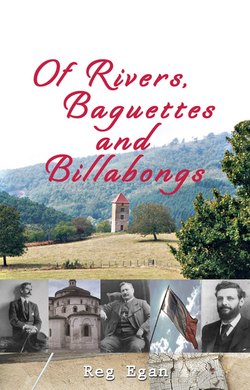Читать книгу Of Rivers, Baguettes and Billabongs - Reg Egan - Страница 8
На сайте Литреса книга снята с продажи.
ОглавлениеCHAPTER TWO
The Dordogne river rises near the centre of France and flows in a general south-westerly direction to join the Garonne some distance to the north of Bordeaux. It is 472 kilometres in length and the streams that mark its origin are the Dore and the Dognon. The Darling rises near Killarney in southern Queensland, Australia and is known there as the Condamine. Several small streams such as the Dumaresque, the Macintyre and the Barwon flow in a general south and south-westerly direction until at the confluence of the Barwon and the Culgoa Rivers that new river becomes the Darling. This river, the Darling then joins the Murray River at Wentworth. The experts tell us that the Darling has a total length of 1867 kilometres — four times as long as the Dordogne.
The Darling, as distinct from some of its tributaries, flows through a relatively arid part of Australia; in fact you could almost claim that today it marks the most westerly part of New South Wales that should reasonably be farmed and grazed. The Dordogne, on the other hand, flows through one of the richest and most varied parts of France: vines, fruit trees, walnuts, poultry (especially geese and ducks), cattle, sheep and goats (and therefore butter and cheese). The Darling and east of the Darling is somewhat sparsely populated but the Dordogne is a valley of villages, towns, farms, woods, native vegetation. In a word, varied.
Such different rivers, such different people! And the thing that intrigues me at the outset is the question: what is it that makes the inhabitants of one country so different to those of another? Why are the French generally so different from the Australians generally? I know, we all know, that it is in part the language, the mixture of races, history, tradition, and so on, but I maintain that it is more than the sum of those relatively minor things. It is in my view the very country itself, its climate, its soil, its sky its indefinable atmosphere. It is everything about the country; its streams, its oceans and beaches, its terroir, to use a French winemaking expression, that produces a population that has characteristics different to and distinct from those, in the case of Australia, of its mother country or countries.
The French have developed the term terroir to a nice point, and it must be said that it has been a commercial success, open to criticism in this modern world though as being rather too unbending. Terroir encompasses more than just the climate and the soil in which the plant or tree grows, or the bird or animal is raised, it encompasses the topography, the geology, the sky, the atmosphere… anything at all which could possibly influence the product, something even in its past, its history, traditional ways and methods. France and Europe are bound closely by tradition and tradition is both good and bad. Australia, on the other hand, may be open to the criticism that we have scant respect for our traditions: we are too eager to be free of everything.
Soil and climate and plant varieties have always fascinated me. Some fifty-five years ago, we decided that we should not only drink wine but that we should grow the grapes and make the wine. I was in the law at the time, and for many reasons, but including the proximity of my practice, we eventually found a four-hectare site facing the Dandenongs in the outer suburbs of Melbourne. We are still there. Now on that small vineyard, we have, for example, three plots of Pinot (interspersed with other varieties) and they all produce differently, ripen at different times and have different characteristics. And yet they are all within two hundred metres of one another a demonstration of terroir in miniature.
Varietal characters are another thing that shouldn’t surprise me but they do: there you have one apple tree planted next to another — same soil, rain, wind and sun — yet one is distinctly different to the other.
People, plants, terroir: a fascinating field for thought and reflection. But perhaps the final word on people and their country comes from an indigenous Australian, Bob Randall, elder of the Yankunytjatjara, the traditional owners of the rock, Ayer’s Rock. These days that wonderful creation is more correctly and colourfully known as Uluru. A short while ago, Bob was doing a lengthy television interview, which was filmed with the rock in the background, and he had many sensible things to say. That rock! Honestly, I’m unashamedly in love with French Gothic cathedrals, and Uluru is the equal of any of them, and even… But to return to Bob Randall. He said this: “The people don’t own the land — the land owns the people.” You’d have to applaud such a summation as that.
